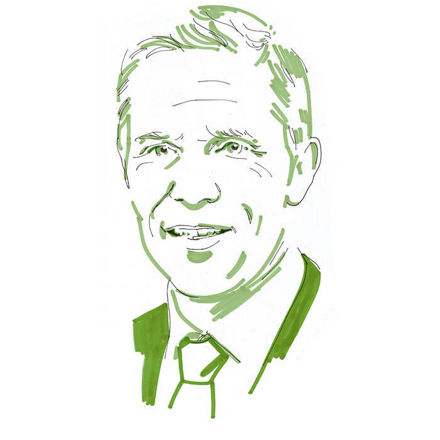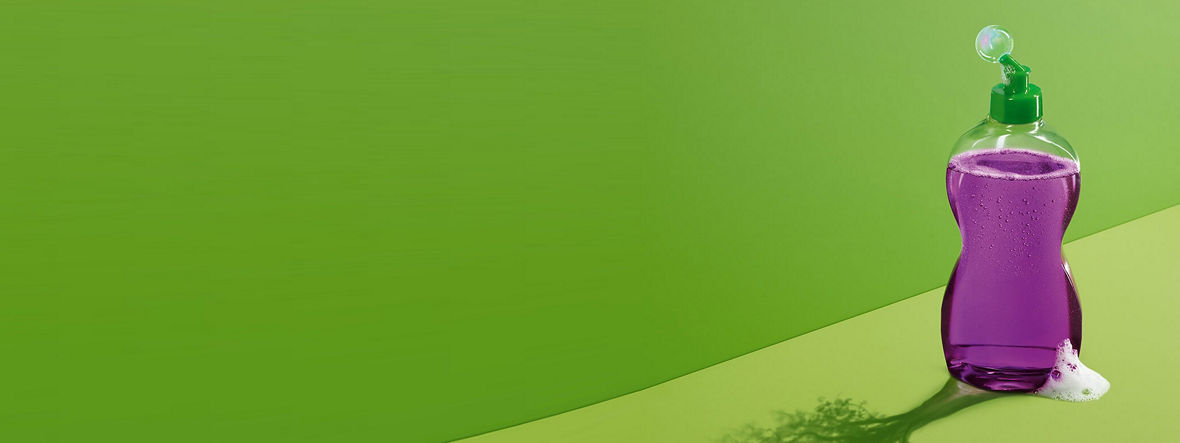For dishwashing testers, activities that most people consider tedious kitchen work are scientific research protocols. Dishes, glasses, and cooking pots are carefully prepared to simulate the challenges faced daily at the kitchen sink: müsli residue sticking to a bowl, dried-out leftover rice in a pot, congealed fat in the frying pan. The test items are then cleaned with various dishwashing detergents under identical conditions and the results are compared.
One important aspect of the results is the “mileage”—a value that, for cars, quantifies the range of travel with a defined amount of fuel. In the dishwashing lab, the mileage is the amount of dishes that the testers can clean before the foam disappears from the dishwater. “The sooner the foam breaks down, the more often the consumer changes the dishwashing water,” says Dr. Hans Henning Wenk, who heads the Care Solutions unit’s research department at Evonik. That means the consumer is using additional water, energy, and dishwashing detergent.
Surfactants are responsible for the formation of foam. Depending on the brand and type, they comprise between five and 30 percent of the contents of a bottle of dishwashing detergent. They are crucial to the product’s efficiency and environmental friendliness. Effective surfactants are thus an important factor in a cleaning product’s sales success.
The annual worldwide sales of surfactants based on biological raw materials amount to more than US$4 billion. The experts expect to see this amount increase to $5.5 billion in 2022 (see Data Mining on page 41). This growth is being driven by consumers who are assigning increasing importance to environmentally friendly solutions, as well as by regulatory bodies that are setting significantly higher standards for the biodegradability of cleaning substances. Europe is an important production location for surfactants—and Evonik is an important player. Together with the consumer goods group Unilever, specialists from Evonik have developed a novel surfactant that not only cleans very well and cares for the skin but is also completely biodegradable. “Biosurfactants are game changers in household cleaning applications and beyond,” says Wenk. “And thanks to our technology, we have the potential to fundamentally change the way cleaning products are manufactured.”
Surfactants work according to a simple principle: They have one end that is attracted to water and another one that bonds with fat (see the graphic on page 39). That’s how they ensure that dissolved dirt doesn’t end up on the dishes again. The new biosurfactant is based on substances called rhamnolipids, which are much better tolerated by aquatic organisms than the surfactants used to date.
HOW SURFACTANTS WORK
Surfactant molecules have a hydrophilic (water-loving) and a lipophilic (fat-loving) end. When a soiled surface is washed with water, the dirt particles attract the lipophilic end, while the hydrophilic end points toward the water. These opposing forces loosen up the dirt particles and dissolve them in the water. There the surfactants cluster around the dirt particles by means of their lipophilic ends and enclose the particles in micelles, which are thrown out together with the wastewater.

A PIONEERING BACTERIUM
The starting point of the cleaning agent is a bacterium that likes to live in dirt: Pseudomonas aeruginosa. It lives in the soil and feeds on fats. It was discovered in 1900 but initially attracted little attention. That may also be due to the fact that it is categorized as a pathogen: If it is ingested in large amounts, it is detrimental to human health. Not until the 1960s did researchers discover that this bacterium produces useful rhamnolipids, even though the amounts are very small. The idea of taking advantage of these lipids’ cleaning abilities initially remained just a vision. But after the genome of this bacterium was decoded in 2000, researchers took up this idea again

There is one surfactant that people have already been using for thousands of years: soap. Eventually soap was replaced by surfactants based on petrochemical raw materials. However, the first generation of these products formed huge mountains of foam on the surface of wastewater and in rivers. The surfactants were not degraded by water purification processes; they escaped into the environment and damaged the organisms living in it. Today surfactants are legally required to be mostly degradable within four weeks in wastewater treatment plants.
Customers have increasingly expressed their desire to use sustainable products that are just as effective as conventional ones. That’s why Hans Henning Wenk and a team of researchers in Essen launched a project in 2008 to develop a new generation of surfactants for cleaning and care products. “Consumers initially accepted the fact that environmentally friendly products were not as good as standard ones,” he recalls. “But today all that is over.” The researchers decided to use rhamnolipids because they are completely biodegradable, both with and without the presence of oxygen. Besides, they remove dirt just as reliably as very good synthetic surfactants. What’s more, they are gentle to the skin—a property the professionals call “mildness.” After washing the dishes, showering or bathing, the user’s skin feels pleasantly cared for.

»Biosurfactants are game changers in household cleaning applications and beyond«
Hans Henning Wenk Head of Research & Development at Care Solutions
Wenk and his colleagues searched for an alternative bacterium that can produce rhamnolipids without posing any risk to human health and gives manufacturers the highest possible yield. They also decided that sugar should serve as the basis of the process, because it is available everywhere from regional sources that are not competing with sensitive ecosystems. “That was a bet on the future,” says Wenk as he looks back at the time and money that were invested in the project. “We really took on something big.”
AN INTERNATIONAL PARTNERSHIP
For production purposes, the team chose a strain of bacteria from the Pseudomonas putida family that is already used in other industrial applications. This is a well-researched safe strain that is not harmful to human beings, animals or plants and that multiplies strongly only under artificial conditions. The strain was then engineered to have the properties needed in the initial bacterium. Step by step, the researchers successfully increased the bacterium’s production capacity to the point where commercial use of the rhamnolipids they produced seemed possible.
Under the microscope, the bacterium does not look spectacular: It has an elongated structure with a couple of filaments at one end. However, rhamnolipids proved to be highly attractive for research purposes. Unilever were aware of this too. In 2015 it became clear that the Dutch-British consumer goods producer was also working to develop surfactants based on rhamnolipids. Thanks to its business relationship with Evonik, a joint development project was born. “Our research and development team has been familiar with rhamnolipids for years. However, the technology and the science had not yet reached the point when industrial production would have been possible,” says Peter Ter Kulve, the President of Unilever’s Home Care business, which is based in London. Evonik contributed its expertise for this “scale-up.” The market potential is tremendous: 2.5 billion people use Unilever products every day. The Home Care division alone posts more than €11 billion in sales annually.

The successful breakthrough to large-scale production was reached in 2016 at the Evonik plant in Slovenská Ľupča, Slovakia. There the Group has for many years employed fermentation specialists who are responsible, among other things, for the production of surfactants based on biological raw materials.
THE CHALLENGE OF FOAM
“If you’re producing 5,000 liters instead of ten liters of a substance, it’s not enough to simply multiply the values,” says Wenk. The pressures, processes, and temperatures must also be adapted. The biggest problem turned out to be the very thing that makes rhamnolipids so attractive to end users: the foam. The product should foam when it’s being used, but not while it’s being produced. If the parameters are correct, production proceeds smoothly (how the production works, you can find out here). Simple glucose is used as the raw material in the fermenters in Slovenská Ľupča. The strain of bacteria converts the sugar into rhamnolipids inside the fermenter at room temperature.
The rhamnolipids have been on the market since 2018. Initially a solution for care products was developed under the name RHEANCE® One. The product was very popular with consumers, and the team of researchers received in-house and external awards for it. But Unilever is aiming at another market: the one for dishwashing detergents. The Group pays special attention to the sustainability of its products and the situation in the emerging economies. There the desire for hygiene and cleanliness is growing, but only a few households have a dishwasher. As a result, there is a big demand for hand dishwashing detergents. What’s more, in many of these countries wastewater is not processed as intensely as it is in industrialized countries. Thus a completely degradable ingredient is an especially big advantage.

The experts from Unilever decided to launch this product on the market in Chile under the very popular brand Quix. The most important selling point was the product’s environmental friendliness—a quality that Chileans prize highly when they make shopping decisions. Unilever evaluates the market launch as a success, and the product will now be introduced in other countries.
Meanwhile, Evonik is considering the construction of a new major production plant. The experts are sure that the need for rhamnolipids will grow by leaps and bounds in the future.


